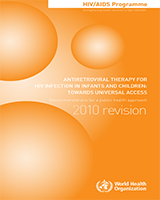All rights reserved. Publications of the World Health Organization can be obtained from WHO Press, World Health Organization, 20 Avenue Appia, 1211 Geneva 27, Switzerland (tel.: +41 22 791 3264; fax: +41 22 791 4857; e-mail: tni.ohw@sredrokoob). Requests for permission to reproduce or translate WHO publications – whether for sale or for noncommercial distribution – should be addressed to WHO Press, at the above address (fax: +41 22 791 4806; e-mail: tni.ohw@snoissimrep).
NCBI Bookshelf. A service of the National Library of Medicine, National Institutes of Health.
Antiretroviral Therapy for HIV Infection in Infants and Children: Towards Universal Access: Recommendations for a Public Health Approach: 2010 Revision. Geneva: World Health Organization; 2010.

Antiretroviral Therapy for HIV Infection in Infants and Children: Towards Universal Access: Recommendations for a Public Health Approach: 2010 Revision.
Show detailsClinical presentation, laboratory abnormalities and implications for ART management
These toxicities may require therapy modification. Alternative explanations for toxicity should be excluded before concluding that it is caused by the ARV drug.
This table describes management of the ART regimen but does not indicate detailed clinical toxicity management
| Possible clinical manifestations (most common ARV drug or drugs associated with the toxicity) | Possible laboratory abnormalities a | Implications for ARV drug treatment | |
|---|---|---|---|
| Acute serious adverse reactions | |||
| Acute, symptomatic hepatitis (NNRTI class, particularly NVP, more rarely EFV; NRTIs or PI class | |||
|
|
| |
| Acute pancreatitis (NRTI class, particularly d4T, ddI; more rarely 3TC) | |||
|
|
| |
| Hypersensitivity reaction (ABC or NVP) | |||
|
|
| |
| Lactic acidosis (NRTI class, particularly d4T) | |||
|
|
| |
| Severe rash/Stevens – Johnson syndrome (NNRTI class, particularly NVP, less common EFV) | |||
|
|
| |
| Severe life-threatening anaemia (AZT) | |||
|
|
| |
| Severe neutropenia (AZT) | |||
|
|
| |
| Chronic late serious adverse reactions | |||
| Lipodystrophy/metabolic syndrome (d4T; PIs) | |||
|
|
| |
| Severe peripheral neuropathy (d4T, ddI; more rarely 3TC) | |||
|
|
| |
- SERIOUS, ACUTE AND CHRONIC TOXICITIES CAUSED BY ARV DRUGS - Antiretroviral Thera...SERIOUS, ACUTE AND CHRONIC TOXICITIES CAUSED BY ARV DRUGS - Antiretroviral Therapy for HIV Infection in Infants and Children: Towards Universal Access
Your browsing activity is empty.
Activity recording is turned off.
See more...